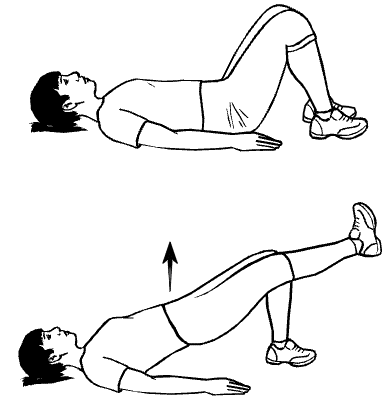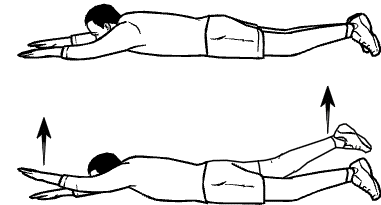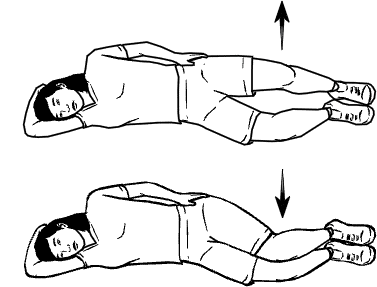Core exercises strengthen the muscles of the spine, abdomen, and pelvis. These muscles support all physical activity.
When core exercises are being done to help with sports performance or injury prevention, it may be necessary to start with very simple exercises and progress to more challenging exercises only when proper exercise techniques have been established.
When core exercises are being done to treat a back injury, it is helpful to get specific recommendations from your doctor or physical therapist before proceeding.
Regular breathing patterns should be maintained during core strengthening exercises—even if many of the exercises require contracting and holding the muscles in one position. Breath-holding can increase blood pressure and decrease the intended strength gains in the muscles.
Core strength helps maintain the spine, hips, and pelvis in a neutral position—even when the arms or legs are moving. Again, a trained therapist can help provide feedback as to the adequacy of maintaining a neutral spine. It may also be possible for the athlete (patient) to sense abnormal movement by placing their hand on the back of the pelvis and sacrum during a stabilization exercise.
One of the most basic core exercises involves a low intensity contraction of the pelvic floor in what is known as a Kegel exercise. This involves tightening the same muscles used to stop the flow of urine. Contracting muscles that gently hollow or draw in the abdominal area below the belly button is also a prerequisite for the proper use of other muscles that help stabilize the spine.



General guidelines
Core exercises should not be painful. When pain develops, exercises may need to be modified or exercises even may need to be stopped. In some cases, it may be necessary to obtain further professional consultation if symptoms persist.When core exercises are being done to help with sports performance or injury prevention, it may be necessary to start with very simple exercises and progress to more challenging exercises only when proper exercise techniques have been established.
When core exercises are being done to treat a back injury, it is helpful to get specific recommendations from your doctor or physical therapist before proceeding.
Regular breathing patterns should be maintained during core strengthening exercises—even if many of the exercises require contracting and holding the muscles in one position. Breath-holding can increase blood pressure and decrease the intended strength gains in the muscles.
Core strength helps maintain the spine, hips, and pelvis in a neutral position—even when the arms or legs are moving. Again, a trained therapist can help provide feedback as to the adequacy of maintaining a neutral spine. It may also be possible for the athlete (patient) to sense abnormal movement by placing their hand on the back of the pelvis and sacrum during a stabilization exercise.
One of the most basic core exercises involves a low intensity contraction of the pelvic floor in what is known as a Kegel exercise. This involves tightening the same muscles used to stop the flow of urine. Contracting muscles that gently hollow or draw in the abdominal area below the belly button is also a prerequisite for the proper use of other muscles that help stabilize the spine.
Examples of core exercises
Bridge with knee extension

- Lie on your back with both knees bent and feet flat on the floor. Place your right and left hands on the floor with arms extended and palms facing the floor.
- Lift your buttocks 1 to 2 inches off the floor and hold this position.
- Keep your pelvis level and still as you slowly straighten a knee. Only your knee should move. Your thighs should remain still.
- Lower your leg to the starting position and then repeat on the other side. Perform 10 repetitions on each leg, alternating between left and right sides.
Superman

- Lie face down on the floor with your arms extended forward.
- Lift your left arm and right leg off the ground. Tighten your abdominal muscles before lifting arms and legs.
- Hold for 1 to 3 seconds then relax.
- Lift your right arm and left leg off the ground. Again tighten your abdominal muscles before initiating.
- Hold for 1 to 3 seconds then relax.
- Repeat. Perform 10 repetitions for steps 2 and 3, and 10 repetitions for steps 4 and 5.
Clam

- Lie on your side in a semi-fetal position. Both hips and knees should be bent to about 45 degrees. Your back should be straight, and hips and shoulders should be at a right angle to the floor (straight up and down).
- Place your top hand on your pelvis to make sure the pelvis does not move.
- Keep your pelvis, low back, and shoulders still, and your heels together, as you slowly raise your top knee toward the ceiling. Only move as far as you are able without letting your pelvis, low back, or shoulders move, then return to the starting position.
- Perform 10 repetitions on one leg, then 10 repetitions on the opposite leg.

Niciun comentariu:
Trimiteți un comentariu